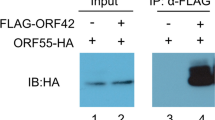Abstract
LNX (Ligand of Numb-protein X) was originally isolated as a binding partner to the cell-fate Determinant Numb during development, and then identified to act as a RING finger-type E3 ubiquitin ligase for the ubiquitylation and degradation of Numb. LNX contains 4 PDZ domains which are proved to play a central role in organizing diverse cell signaling assemblies. A yeast two-hybrid screening was used to identify LNX as a potential binding partner for RhoC. RhoC, a member of the Ras family of small GTPases, promotes reorganization of the actin cytoskeleton and regulation of cell shape, attachment, and motility. The interaction between LNX and RhoC in mammalian cells was identified by co-immunoprecipitation assays, and the efficient binding required the first PDZ domain of LNX. LNX and RhoC were further colocalized with each other in mammalian cells, in which RhoC changed its sublocalization from cytoplasm to nucleus when co-transferred with LNX. Furthermore, co-expression of RhoC reduced the transcriptional activity of AP-1, which was up-regulated by over-expression of LNX alone. These results suggest that LNX and RhoC might be part of a larger protein complex that would have important functions in signaling transduction about regulating the transcriptional activities of AP-1.




Similar content being viewed by others
References
Caviness VS, Takahashi T, Nowakowski RS (1995) Numbers, time and neocortical neuronogenesis: a general developmental and evolutionary model. Trends Neurosci 18:379–383
McConnell SK (1995) Constructing the cerebral cortex: neurogenesis and fate determination. Neuron 15:761–768
Rhyu MS, Jan LY, Jan YN (1994) Asymmetric distribution of Numb protein during division of the sensory organ precursor cell confers distinct fates to daughter cells. Cell 76:477–491
Spana EP, Kopczynski C, Goodman CS, Doe CQ (1995) Asymmetric localization of Numb autonomously determines sibling neuron identity in the Drosophila CNS. Development 121:3489–3494
Vervoort M, Dambly-Chaudiere C, Ghysen A (1997) Cell fate determination in Drosophila. Curr Opin Neurobiol 7:21–28
Guo M, Jan LY, Jan YN (1996) Control of daughter cell fates during asymmetric division: interaction of Numb and Notch. Neuron 17:27–41
Spana EP, Doe CQ (1996) Numbantagonizes Notch signaling to specify sibling neuron cell fates. Neuron 17:21–26
Dho S, Jacob S, Wolting C, French M, Rohrschneider L, McGlade CJ (1998) The Mammalian Numb Phosphotyrosine-binding Domain. Characterization of binding specificity and identification of a novel PDZ domain-containing numb binding protein, LNX. J Biol Chem 273:9179–9187
Nie J, McGill M, Dermer M, Dho S, Wolting C, McGlade CJ (2002) LNX functions as a RING type E3 ubiquitin ligase that targets the cell fate determinant Numb for ubiquitin-dependent degradation. EMBO J 21:93–102
Nie J, Li S, McGlade CJ (2004) A novel PTB-PDZ domain interaction mediates isoform-specific ubiquitylation of mammalian Numb. J Biol Chem 279:20807–20815
Rice D, Northcutt G, Kurschner C (2001) The Lnx family proteins function as molecular scaffolds for Numb family proteins. Mol Cell Neurosci 18:525–540
Kansaku A, Hirabayashi S, Mori H, Fujiwara N, Kawata A, Ikeda M, Rokukawa C, Kurihara H, Hata Y (2006) Ligand-of-Numb protein X is an endocytic scaffold for junctional adhesion molecule 4. Oncogene 25:5071–5084
Ponting CP, Phillips C, Davies KE, Blake DJ (1997) PDZ domains: targeting signalling molecules to sub-membranous sites. Bioessays 19:469–479
Chen J, Xu J, Zhao W, Hu G, Cheng H, Kang Y, Xie Y, Lu Y (2005) Characterization of human LNX, a novel ligand of Numb protein X that is downregulated in human gliomas. Int J Biochem Cell Biol 37:2273–2283
Etienne-Manneville S, Hall A (2002) Rho GTPases in cell biology. Nature 420:629–635
Nicolas T, Alan H (1997) Rho, Rac and Cdc42 GTPases regulate the organization of the actin cytoskeleton. Curr Opin Cell Biol 9:86–92
Sahai E, Marshall CJ (2002) RHO-GTPases and Cancer. Nat Rev Cancer 2:133–142
Susumu H, Takashi T, Eiji I, Isao K, Toshihisa O (2007) The active zone protein CAST directly associates with Ligand-of-Numb protein X. Biochem Bioph Res Co 354:686–692
Weiss A, Baumgartner M, Radziwill G, Dennler J, Moelling K (2007) c-Src is a PDZ interaction partner and substrate of the E3 ubiquitin ligase Ligand-of-Numb protein X1. FEBS Lett 581:5131–5136
Uemura T, Shepherd S, Ackerman L, Jan LY, Jan YN (1989) Numb, a gene required in determination of cell fate during sensory organ formation in Drosophila embryos. Cell 58:349–360
Pawson T, Scott JD (1997) Signaling through scaffold, anchoring and adapter proteins. Science 278:2075
Wheeler A, Ridley A (2004) Why three Rho proteins? RhoA, RhoB, RhoC, and cell motility. Exp Cell Res 301:43–49
Wenandy L, Sørensen R, Svane I, Straten P, Andersen M (2008) RhoC a new target for therapeutic vaccination against metastatic cancer. Cancer Immunol Immun 57:1871–1878
Harris B, Lim W (2001) Mechanism and role of PDZ domains in signaling complex assembly. J Cell Sci 114:3219–3231
Hess J, Angel P, Schorpp-Kistner M (2004) AP-1 subunits: quarrel and harmony among siblings. J Cell Sci 117:5965–5973
Sollerbrant K, Raschperger E, Mirza M, Engstromr U, Philipson L, Ljungdahl P, Pettersson R (2003) The Coxsackievirus and Adenovirus Receptor (CAR) Forms a Complex with the PDZ Domain-containing Protein Ligand-of-Numb Protein-X (LNX). J Biol Chem 278:7439–7444
Ridley AJ (2004) Rho proteins and cancer. Breast Cancer Res Treat 84:13–19
Hakem A, Sanchez-Sweatman O, You-Ten A, Gordon D, Wakeham A, Khokha R, Mak T (2005) RhoC is dispensable for embryogenesis and tumor initiation but essential for metastasis. Gene Dev 19:1974–1979
Acknowledgments
This work was supported by the National Science Foundation of China (No. 30671145).
Author information
Authors and Affiliations
Corresponding author
Rights and permissions
About this article
Cite this article
Zheng, D., Sun, Y., Gu, S. et al. LNX (Ligand of Numb-protein X) interacts with RhoC, both of which regulate AP-1-mediated transcriptional activation. Mol Biol Rep 37, 2431–2437 (2010). https://doi.org/10.1007/s11033-009-9754-5
Received:
Accepted:
Published:
Issue Date:
DOI: https://doi.org/10.1007/s11033-009-9754-5




